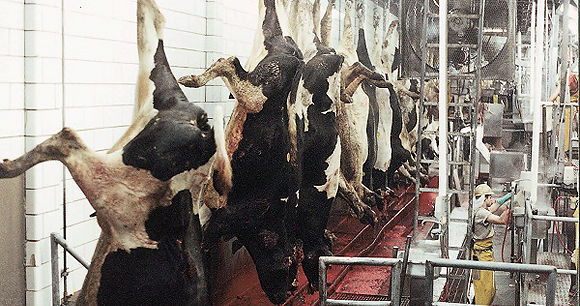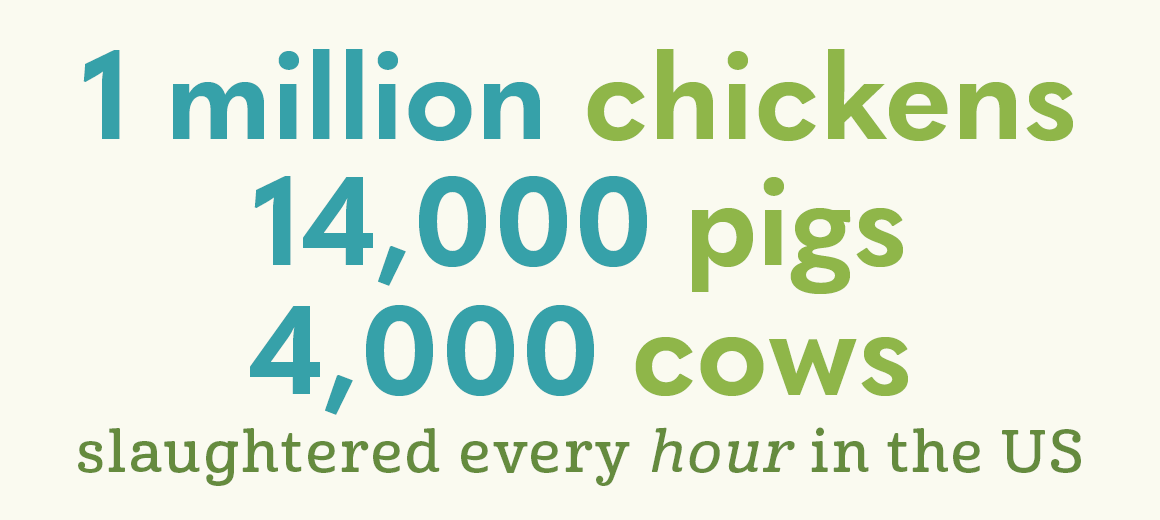
Every hour, some 1,000,000 chickens, 14,000 pigs, and 4,000 cows are slaughtered for human consumption in the United States. It is a process that takes place far from public view, and one that few know very much about.
In the past, revelations about cruelty to animals during the slaughtering process resulted in actions by Congress to improve enforcement of the federal law created to protect animals at slaughter—primarily the Humane Methods of Slaughter Act (HMSA). Despite congressional action, however, enforcement of the HMSA by the US Department of Agriculture remains lacking.
AWI worked diligently for passage of the original law in 1958 and for a 1978 amendment that provided for enforcement. The HMSA requires humane handling before slaughter, as well as the rendering of animals insensible to pain (a process referred to as “stunning”) prior to being shackled, hoisted, or cut.

The HMSA applies to the roughly 166 million livestock killed each year at approximately 800 federally inspected slaughter plants, and to a much smaller number of animals killed at approximately 1,900 state-inspected plants.
Shamefully, the HMSA does not protect the approximately 9.5 billion chickens, 208 million turkeys, and 26.6 million ducks slaughtered each year in the United States, nor does it apply to animals killed on the farm.
Humane Slaughter Violations
The HMSA requires that all cattle, pigs, sheep, and goats be humanely handled at all times when on the premises of a federally or state-inspected slaughter plant. Regulations to implement the law were adopted by the USDA in the late 1970s.
What constitutes a humane slaughter violation under the regulations?
- Driving animals off trucks and down ramps using excessive force or otherwise means likely to cause undue excitement and discomfort
- Failure to move any animal unable to walk off the truck on suitable equipment or to stun the animal before being moved
- Dragging a conscious animal
- Failure to separate disabled animals from ambulatory animals and/or to place them in a covered pen
- Failure to provide animals with access to water, access to feed if held over 24 hours, and sufficient room to lie down if held overnight
- Excessive use of electric prods to move animals
- Failure to maintain facilities and equipment in good repair to prevent injury or pain to the animals
- Making more than one attempt to render an animal unconscious by stunning and/or causing excitement or discomfort during stunning
- Shackling, hoisting, or cutting still-conscious animals
AWI has petitioned the USDA numerous times over the past decade for improvements to the HMSA regulations and for improved enforcement of the law. For AWI’s analysis of how the USDA oversees the handling of livestock at slaughter in the United States, see Humane Slaughter Update: Federal and State Oversight of the Welfare of Farm Animals at Slaughter.
Read AWI's petitions to the USDA on the HMSA regulations and their enforcement:
- 2023 Petition to Require Video Cameras in CO2 Gas Slaughter Systems
- 2023 Petition on Humane Handling Oversight at Custom-Exempt Establishments
- 2013 Petition on Enforcement of the Humane Methods of Slaughter Act
- 2010 Petition on Enforcement of the Humane Methods of Slaughter Act
For a description of how the USDA oversees the treatment of birds, see AWI’s report on poultry slaughter in the United States. Also see AWI’s petition to the USDA on the handling of birds at slaughter.
Are USDA records and reports related to humane slaughter violations available to the public?
The USDA posts on its website numerous records and reports related to the treatment of both livestock and poultry at slaughter. This information can be accessed at the following links:
- HMSA Humane Handling Enforcement Actions (list of livestock slaughter plants suspended from operations due to egregious or repeated humane handling violations; archived for one year only)
- HMSA Humane Handling Quarterly Enforcement Reports (violations at livestock slaughter plants summarized by USDA district and size of slaughter plant; FY2021 on)
- Livestock and Poultry Humane Handling Enforcement Records (cited violations at individual livestock and poultry slaughter plants; 2021 on)
- Livestock and Poultry Humane Handling Enforcement Records (cited violations at individual livestock and poultry slaughter plants; 2017–2020)